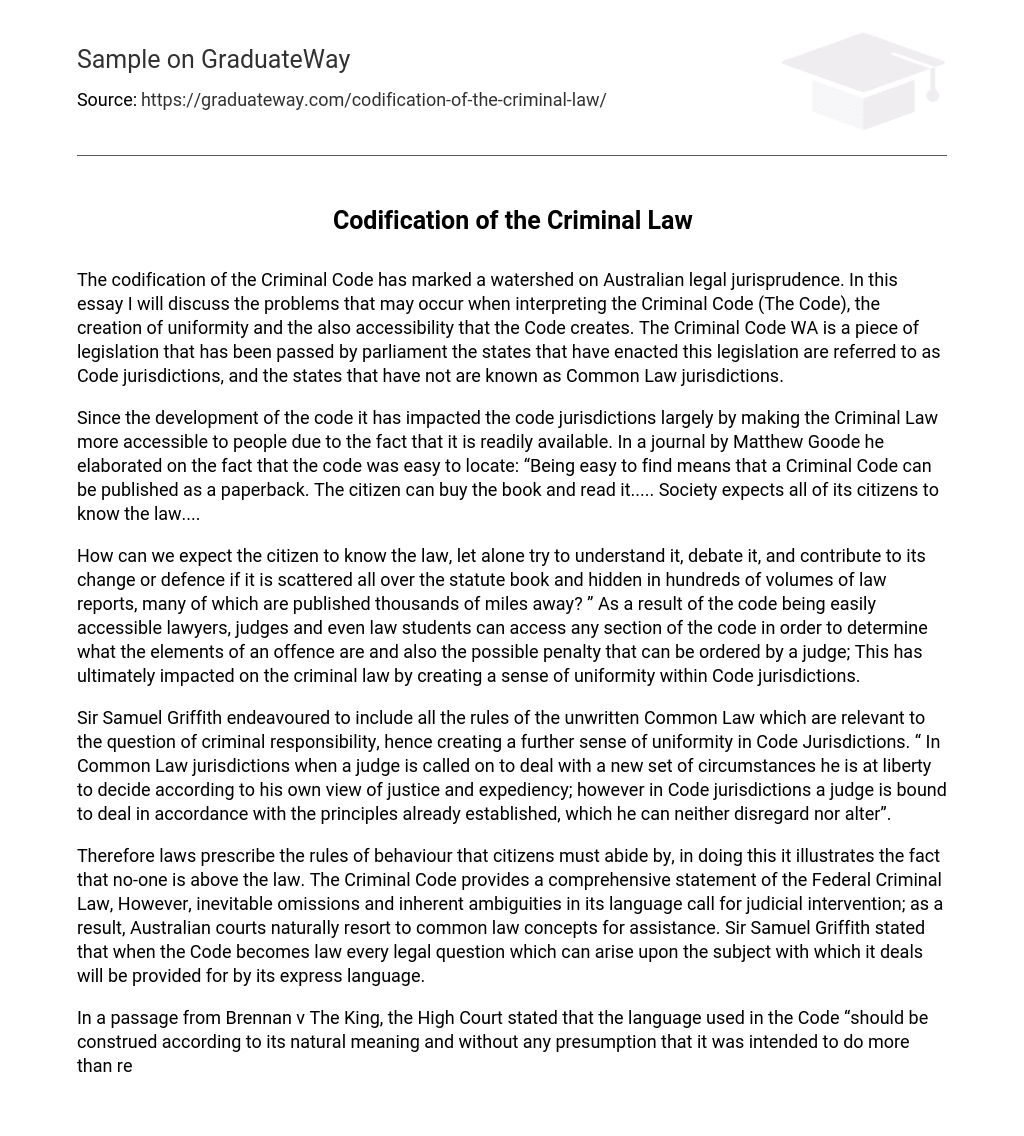The codification of the Criminal Code has marked a watershed on Australian legal jurisprudence. In this essay I will discuss the problems that may occur when interpreting the Criminal Code (The Code), the creation of uniformity and the also accessibility that the Code creates. The Criminal Code WA is a piece of legislation that has been passed by parliament the states that have enacted this legislation are referred to as Code jurisdictions, and the states that have not are known as Common Law jurisdictions.
Since the development of the code it has impacted the code jurisdictions largely by making the Criminal Law more accessible to people due to the fact that it is readily available. In a journal by Matthew Goode he elaborated on the fact that the code was easy to locate: “Being easy to find means that a Criminal Code can be published as a paperback. The citizen can buy the book and read it….. Society expects all of its citizens to know the law….
How can we expect the citizen to know the law, let alone try to understand it, debate it, and contribute to its change or defence if it is scattered all over the statute book and hidden in hundreds of volumes of law reports, many of which are published thousands of miles away? ” As a result of the code being easily accessible lawyers, judges and even law students can access any section of the code in order to determine what the elements of an offence are and also the possible penalty that can be ordered by a judge; This has ultimately impacted on the criminal law by creating a sense of uniformity within Code jurisdictions.
Sir Samuel Griffith endeavoured to include all the rules of the unwritten Common Law which are relevant to the question of criminal responsibility, hence creating a further sense of uniformity in Code Jurisdictions. “ In Common Law jurisdictions when a judge is called on to deal with a new set of circumstances he is at liberty to decide according to his own view of justice and expediency; however in Code jurisdictions a judge is bound to deal in accordance with the principles already established, which he can neither disregard nor alter”.
Therefore laws prescribe the rules of behaviour that citizens must abide by, in doing this it illustrates the fact that no-one is above the law. The Criminal Code provides a comprehensive statement of the Federal Criminal Law, However, inevitable omissions and inherent ambiguities in its language call for judicial intervention; as a result, Australian courts naturally resort to common law concepts for assistance. Sir Samuel Griffith stated that when the Code becomes law every legal question which can arise upon the subject with which it deals will be provided for by its express language.
In a passage from Brennan v The King, the High Court stated that the language used in the Code “should be construed according to its natural meaning and without any presumption that it was intended to do more than restate the existing law” Such a principle in interpretation “represents a contribution by the Court, where that course is sustained by the language of the code in question, to the achievement of a desirable uniformity in basic principles of the criminal law throughout Australia”.
The pre-existing common law is, therefore, frequently woven into the fabric of the Code by judges due to its familiarity and also because it offers the advantage of maintaining a uniform basis for our laws. In my opinion I believe that the Code has largely impacted Australian jurisprudence due to the fact that it has created uniformity within Code jurisdictions.
With this uniformity it has provided social cohesion and allows everyone to be subject to the same legal principles and leaves minimal interpretation on behalf of the judges when interpretation law. The Criminal law of Australia has been codified in some jurisdictions within Australia and I believe that a Model Criminal code should be applied to the whole of Australia.





